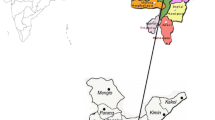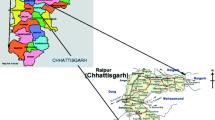Abstract
The Muskingum-based (MK-based) distributions and their probability weighted moments (PWMs) have been used for frequency calculation of hydrological data that contain zero values. However, the performance of different MK-based distributions have not been compared and evaluated. Moreover, the partial L-moments (PLMs), which are used for analyzing censored samples, have not been used for frequency calculation of such hydrological data. To obtain the most effective method, this study compares and evaluates the performance of four MK-based distributions by fitting 64 monthly precipitation series and using the ordinary least square (OLS) criterion, Akaike information criterion (AIC), residual square sum criterion (RSS), and the Quasi-optimal Deterministic coefficient (QD). The distributions include exponential distribution combines with Dirac delta function (M-like), two-parameter gamma distribution (GA2) combines with Dirac delta function (DGA2), two-parameter generalized Pareto distribution combines with Dirac delta function (DGP2), and two-parameter Weibull distribution (WB2) combines with Dirac delta function (DWB2). The applicability of PLMs were also tested and PLMs of four traditional distributions, including GA2, WB2, generalized extreme value distribution (GEV) and three-parameter generalized Pareto distribution (GP3) were used in application. Results showed that the PLMs are feasible for frequency calculation of hydrological data with zeros. The DGP2 and GP3 are superior to the other MK-based distributions and traditional distributions, respectively. The DGP2 distribution is the optimal choice in most cases and is more universal than the other distributions.




Similar content being viewed by others
Availability of Data and Material
Some or all data, models, or code generated or used in the study are available from the corresponding author by request.
Code Availability
Some or all code generated or used in the study are available from the corresponding author by request.
References
Azhdari Z, Bazrafshan O, Zamani H, Shekari M, Singh VP (2021) Hydro-meteorological drought risk assessment using linear and nonlinear multivariate methods. Phys Chem Earth 123:103046
Bhattarai KP (2004) Partial L-moments for the analysis of censored flood samples. Hydrolog Sci J 49(5):855–868
Bonaccorso B, Peres D, Castano A, Cancelliere A (2015) SPI-Based Probabilistic Analysis of Drought Areal Extent in Sicily. Water Resour Manag 29(2):459–470
Deng S, Chen T, Yang N, Qu L, Li M, Chen D (2018) Spatial and temporal distribution of rainfall and drought characteristics across the Pearl River basin. Sci Total Environ 619–620:28–41
Greenwood JA, Landwehr JM, Matalas NC, Wallis JR (1979) Probability weighted moments: definition and relation to parameters of several distributions expressible in inverse form. Water Resour Res 15(5):1049–1054
Hamed K, Rao AR (1999) Flood frequency analysis. Taylor & Francis Inc, Bosa Roca, United States
Hosking JRM (1990) L-moments: analysis and estimation of distributions using linear combinations of order statistics. J R Stat Soc Ser B (Methodological) 52(2):105–124
Jennings ME, Benson MA (1969) Frequency curves for annual flood series with some zero events or incomplete data. Water Resour Res 5(1):276–280
Jeon J, Kim Y, Kim Y (2011) Expected probability weighted moment estimator for censored flood data. Adv Water Resour 34(8):933–945
Li L, Yao N, Liu DL, Song S, Lin H, Chen X, Li Y (2019) Historical and future projected frequency of extreme precipitation indicators using the optimized cumulative distribution functions in China. J Hydrol 579:124170
Moisello U (2007) On the use of partial probability weighted moments in the analysis of hydrological extremes. Hydrol Process 21(10):1265–1279
Myronidis D, Ioannou K, Fotakis D, Dorflinger G (2018) Streamflow and hydrological drought trend analysis and forecasting in Cyprus. Water Resour Manag 32(5):1759–1776
Nazeri Tahroudi M, Ramezani Y, De Michele C, Mirabbasi R (2020) A new method for joint frequency analysis of modified precipitation anomaly percentage and streamflow drought index based on the conditional density of copula functions. Water Resour Manag 34(13):4217–4231
Song X, Song S, Sun W, Mu X, Wang S, Li J, Li Y (2015) Recent changes in extreme precipitation and drought over the Songhua River Basin, China, during 1960–2013. Atmos Res 157:137–152
Stedinger JR (1987) Plotting positions for historical floods and their precision. Water Resour RES 23(4):715–727
Stedinger JR (1993) Frequency analysis of extreme events. Handb Hydrol 18
Strupczewski WG, Weglarczyk S, Singh VP (2003) Impulse response of the kinematic diffusion model as a probability distribution of hydrologic samples with zero values. J Hydrol 3(270):328–351
Sun W, Mu X, Song X, Wu D, Cheng A, Qiu B (2016) Changes in extreme temperature and precipitation events in the Loess Plateau (China) during 1960–2013 under global warming. Atmos Res 168(Feb.):33–48
Trenberth KE, Dai A, van der Schrier G, Jones PD, Barichivich J, Briffa KR, Sheffield J (2013) Global warming and changes in drought. Nat Clim Change 4(1):17–22
Wang QJ (1990) Estimation of the GEV distribution from censored samples by method of partial probability weighted moments. J Hydrol 120(1–4):103–114
Wang QJ (1996) Using partial probability weighted moments to fit the extreme value distributions to censored samples. Water Resour Res 32(6):1767–1771
Wang SX, Singh V (1995) Frequency estimation for hydrological samples with zero values. J Water Res Plan Man 121(1):98–108
Weglarczyk S, Strupczewski WG, Singh VP (2005) Three-parameter discontinuous distributions for hydrological samples with zero values. Hydrol Process 19(15):2899–2914
Wei T, Song SB (2019) Probability weighted moments-based parameter estimation for kinematic diffusion and muskingum-based distributions. J Hydrol Eng 12(24):4019054
Woo M, Wu K (1989) Fitting annual floods with zero-flows. Can Water Resour J 14(2):10–16
Wu CL, Chau KW (2013) Prediction of rainfall time series using modular soft computing methods. Eng Appl ArtifF Intel 26(3):997–1007
Wu CL, Chau KW, Fan C (2010) Prediction of rainfall time series using modular artificial neural networks coupled with data-preprocessing techniques. J Hydrol 389(1):146–167
Zakaria ZA, Shabri A, Ahmad UN (2012) Estimation of the generalized logistic distribution of extreme events using partial L-moments. Hydrolog Sci J 57(3):424–432
Zakaria ZA, Shabri A, Nadiah Ahmad U (2011) Estimation of generalized pareto distribution from censored flood samples using partial L-moments. J Math Res 3(1)
Zhang D, Han D, Song X (2020) Impacts of the sanmenxia dam on the interaction between surface water and groundwater in the lower weihe river of yellow river watershed. Water-SuiI 12(6):1671
Zhang T, Su X, Feng K (2021) The development of a novel nonstationary meteorological and hydrological drought index using the climatic and anthropogenic indices as covariates. Sci Total Environ 786:147385
Zhao C, Brissette F, Chen J, Martel J (2020) Frequency change of future extreme summer meteorological and hydrological droughts over North America. J Hydrol 584:124316
Acknowledgements
We are grateful for the support received as part of the projects funded by the National Natural Science Foundation of China (Grant No. 52079110). Additionally, we would like to extend sincere appreciation to the editor and anonymous reviewers for their constructive comments, which help to improve the quality of the manuscript substantially.
Funding
The present study is supported by the National Natural Science Foundation of China (Grant No. 52079110).
Author information
Authors and Affiliations
Contributions
Ting Wei: Data analysis, Calculation, Writing, Editing and Review. Songbai Song: Conceptualization, Methodology, Funding acquisition. Both authors read and approved the final manuscript.
Corresponding author
Ethics declarations
Ethical Approval
Not applicable.
Consent to Participate
Not applicable.
Consent to Publish
Not applicable.
Competing Interest
The authors declare that they have no conflict of interest to this work.
Additional information
Publisher's Note
Springer Nature remains neutral with regard to jurisdictional claims in published maps and institutional affiliations.
Appendices
Appendix
1.1 Pdfs of GA2, GP2, WB2, GEV and GP3 Distributions
The pdf of GA2 distribution is given by
where a and b are the scale and shape parameters of GA2, respectively; \(\Gamma \left( b \right)\) is gamma function.
The pdf of GP2 distribution is given by
where a and b are the scale parameter and shape parameter of GP2 distribution, respectively.
The pdf of WB2 distribution is given by
where a and b are the scale parameter and shape parameter of WB2 distribution, respectively.
The distribution function of GP3 distribution is given by
where ξ, α, and k are the location, scale and shape parameters of the GP3 distribution, respectively.
The pdf of GEV distribution is given by
where ξ, α, and k are the location, scale and shape parameters of the GEV distribution, respectively.
1.2 PWMs of Muskingum-based Distributions
According to the definition of PWM given by (Greenwood et al. 1979), the PWMs for the distribution shown in Eq. (2) can be written as
For the M-like distribution, the first two order PWMs are derived as
For the DGA2 distribution, the first three order PWMs are derived as
where \(B\left( {x,y} \right)\) is the beta function and \({I_z}\left( {x,y} \right)\) is the incomplete beta function.
For the DGP2 distribution, the first three order PWMs are derived as
For the DWB2 distribution, the first three order PWMs are derived as:
1.3 Parameters Estimation for GA2 Distribution Using PLMs
Substituting Eq. (23) into Eq. (13), one obtains the lower censored PPWMs of GA2 distribution as
where x0 being the lower censoring threshold.
Let \(y = {x \mathord{\left/ {\vphantom {x a}} \right. \kern-\nulldelimiterspace} a}\) and \(u = {t \mathord{\left/ {\vphantom {t a}} \right. \kern-\nulldelimiterspace} a}\), Eq. (40) can be written as
where
Let r = 0 and 1, one gets
where \(P\left( {a,x} \right)\) is the incomplete gamma function, and
With the use of the properties of both the gamma function and the incomplete gamma function, Eqs. (45) and (46) are derived as
where \(B\left( {x,y} \right)\) is the beta function.
Substituting Eqs. (47) and (48) into Eq. (44), we obtain
Combining Eqs. (14) and (15), one obtains
1.4 Parameters Estimation for WB2 Distribution Using PLMs
According to Eqs. (12) and (25), the PPWMs of WB2 distribution are derived as
Using Eqs. (52) and (53) one can write
The curve of z vs. a can be approximated by a quadratic function of the form
For a fixed F0, five z values can be calculated by the right side of Eq. (54), corresponding to five given a values, e.g. a = 0.1–0.5. Substituting these calculated z values into Eq. (55) yields a set of linear equations. One can then get the solutions for a0, a1 and a2 corresponding to that fixed value of F0.
Replacing the values of the PPWM \({\alpha ^{\prime}_0}\) and \({\alpha ^{\prime}_1}\) in Eq. (54) by the PLMs \({\lambda ^{\prime}_1}\) and \({\lambda ^{\prime}_2}\) shown in Eqs. (14)-(15), one can write
The sample estimate \(\hat z\) can then be obtained by replacing \({\lambda ^{\prime}_1}\) and \({\lambda ^{\prime}_2}\) by their sample estimate \({l^{\prime}_1}\) and \({l^{\prime}_2}\).
Substituting Eq. (57) and the estimates of a0, a1 and a2 in Eq. (55), one can get the estimate for \(\hat a\). The parameter b can then be obtained successively from Eq. (58).
The Optimal Distribution for Each Station
Rights and permissions
About this article
Cite this article
Wei, T., Song, S. Comparison of Frequency Calculation Methods for Precipitation Series Containing Zero Values. Water Resour Manage 36, 527–550 (2022). https://doi.org/10.1007/s11269-021-03038-4
Received:
Accepted:
Published:
Issue Date:
DOI: https://doi.org/10.1007/s11269-021-03038-4




